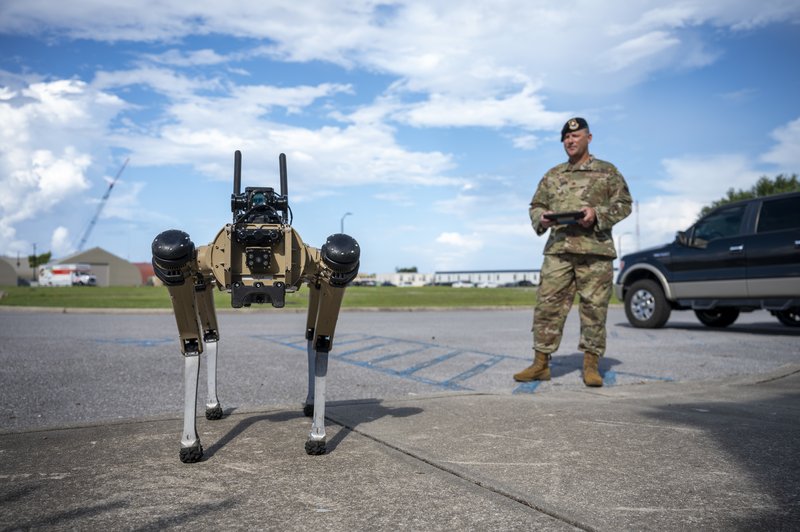The future of the UGV market: A battlefield revolution in the making (opinion)
The Milrem THeMIS UGV participates in the 2024 Army Expeditionary Warrior Experiment in January 2024. (Photo: US Army)
UGVs are not merely another tool in modern warfare’s arsenal – they represent a shift in how conflicts will be fought and how human life will be preserved on the frontlines.
At its core, the UGV market is driven by the demand for cheap mass. NATO forces, among others, are increasingly seeking ways to reduce the reliance on human soldiers and crewed vehicles.
UGVs offer a solution: platforms that are less costly in terms of both economic and human resources. This shift allows forces to deploy assets capable of sustaining losses without creating the risk of human casualties.
Emerging applications
The versatility of UGVs is key to their rising importance. In the short term, the focus is largely on last-mile resupply and combat service support roles. These are non-aggressive tasks, designed to deliver supplies or conduct engineering operations in high-risk areas without exposing soldiers to danger.
The market, however, is poised for significant growth in more aggressive roles. Combat UGVs, capable of engaging the enemy directly, will likely emerge as central to military operations by the early 2030s.
In fact, one of the most disturbing developments on the horizon is the introduction of “drone swarms” in ground operations.
We have already seen the impact of drone swarms in the air domain, and applying similar technologies to the ground – deploying hundreds or even thousands of small UGVs equipped with sensors or explosives – could overwhelm traditional defences. This tactic has the potential to revolutionise how battles are fought, replacing human soldiers in the most dangerous engagements.
Powering the future: Hybrid engines and autonomy
The technology powering these vehicles is also advancing at an incredible rate. Combining diesel engines with electric motors, hybrid power systems are becoming the minimum standard for UGVs.
The benefits are clear: hybrid engines allow for "silent watch" and "silent running," drastically reducing the noise signature of UGVs on the battlefield. The ability to operate without being detected or to power up communication systems for extended periods without resupply makes UGVs indispensable.
However, the true breakthrough will come when these vehicles achieve full autonomy. At present, most UGVs require human operators to make critical decisions – there is a lag between the vehicle being shot at and it taking cover, for example.
Autonomous tactical behaviour is still immature, but it is progressing. When UGVs can react independently to battlefield threats, the advantages they offer will multiply exponentially.
US vs Europe: A diverging market
While Europe remains cautious, largely due to political constraints, the US is forging ahead. Programs like SMET (Small Multipurpose Equipment Transport) and the Robotic Combat Vehicle (RCV) initiative are already rolling out large numbers of UGVs.
The US has successfully ordered hundreds of units, with more contracts expected imminently, whereas Europe remains in the trial phase, tinkering with a handful of prototypes.
This is partly due to Europe’s reluctance to engage in armed UGV development, given the political backlash against "killer robots." Yet, as we have seen with uncrewed aerial systems (UAS), such attitudes can shift rapidly in the face of real-world conflicts.

Russia and China, too, are key players in this space. China’s investment in autonomous systems, both aerial and ground-based, dwarfs most Western efforts and they are already deploying these technologies in their military exercises.
Meanwhile, Russia’s use of UGVs in Syria and Ukraine has demonstrated how these systems can function in active conflict zones, offering a glimpse of the role UGVs could play in future peer-on-peer conflicts.
The next 10 years
Looking ahead, the UGV market is on a two-track trajectory. In the absence of a major conflict, we can expect gradual integration of UGVs in combat support roles, expanding to armed roles by 2030.
By 2035, combat UGVs could be operating in large numbers, taking on more traditional soldier roles in direct conflict zones. If a major conflict arises sooner, this timeline could accelerate dramatically, as the political and social resistance to autonomous armed systems diminishes in the face of battlefield necessity.
The UGV market is poised for rapid expansion. Manufacturers have an opportunity to enter a relatively low-barrier market and influence the future of military operations.
The demand for intelligent logistics, surveillance and combat capabilities will only grow, particularly as autonomy and hybrid technologies mature.
For the defence industry, this is a dynamic and potentially disruptive space. For soldiers on the ground, it might just save their lives.
Sam Hart is the Senior Land Analyst at Shephard Defence Insight, focusing on uncrewed ground vehicles, armoured vehicles and artillery systems
More from Land Warfare
-
![British Army’s commitment to L118 105mm light gun may be death knell for Light Fires Platform]()
British Army’s commitment to L118 105mm light gun may be death knell for Light Fires Platform
The UK Defence Science and Technology Laboratory (Dstl) was running the programme for the Light Fires Platform (LFP) which was touted as the replacement for the 105mm L118 Light Gun used by the Royal Artillery (RA) regular and reserve units.
-
![Lockheed Martin successfully fires latest Precision Strike Missile as programme progresses]()
Lockheed Martin successfully fires latest Precision Strike Missile as programme progresses
Lockheed Martin’s Precision Strike Missile (PrSM) is a next-generation surface-to-surface missile system designed as a replacement and significant upgrade over legacy systems. A key role for PrSM will be for operations from M142 High Mobility Artillery Rocket System (HIMARS) and Multiple Launch Rocket System (MLRS) M270A2 launcher.
-
![Australia embraces quantum technology for precise navigation and targeting]()
Australia embraces quantum technology for precise navigation and targeting
A new project is aiming to deliver a ground-to-satellite optical quantum link, which would allow much more precise battle planning.





















